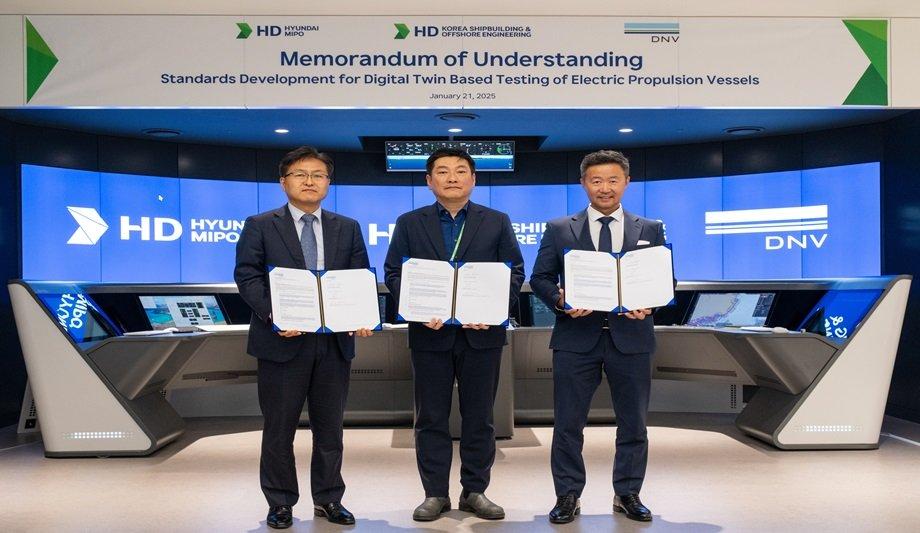DNV has signed a Memorandum of Understanding (MoU) with HD Hyundai Mipo (HMD) and HD Korea Shipbuilding & Offshore Engineering (KSOE).
The collaboration focuses on developing standards for testing electric-powered vessels through the use of digital twin-based criteria and procedures, to enhance ship safety and efficiency.
Hardware-in-the-loop (HiL) testing
This collaborative project aims to resolve issues related to the integration of highly complex vessel systems for electric propulsion.
Utilising hardware-in-the-loop (HiL) testing via digital twins of the different systems enables integration tests to be performed both earlier in the process on a much broader and deeper level.
Digital asset verification
Having the same requirements and HiL test procedures ensures the reliability of the testing
To ensure the accuracy of the tests, however, users need to be confident in the digital assets. Together DNV, HMD, and KSOE are working on the verification of these digital assets. Utilising DNV verified digital assets, will facilitate the integration process.
In addition, when systems from multiple suppliers are tested together, having the same requirements and HiL test procedures ensures the reliability of the testing.
Digital twin-based testing procedures
Kitae Kim, Head of Quality Management, HD Hyundai Mipo, said, "Through this technical collaboration we aim to establish clear and practical digital twin-based testing procedures and standards."
Kitae Kim adds, "These can foster broader industry participation and ensure the reliability of results. In doing so, we hope to safeguard the performance and safety of ship systems and lead in building a digital twin ecosystem for the shipbuilding industry."
Vessel performance and quality
Byoung Hun Kwon, Head of the Electrification Center/Digital Technology Research Lab, at HD KSOE, said, "We have proactively developed and implemented digital twin technology, including HiL, to safeguard the performance and quality of vessels, achieving world-class advancements in virtual commissioning technology."
Byoung Hun Kwon adds, "This collaboration marks a pivotal milestone, uniting HD Hyundai Mipo, HD KSOE, and DNV to drive digital innovation in the shipbuilding and marine industry."
Maritime digitalisation
Andreas Kristoffersen, Head of Approval Centre Korea and DNV Maritime, said, "This MoU highlights HMD, KSOE, and DNV’s commitment to driving digitalisation in the maritime industry."
Andreas Kristoffersen adds, "By adopting digital twin-based testing for complex systems, we are working together to shape the future of maritime operations and set new industry standards for safety and performance."
Plug-and-play
The project will focus on maintaining digital assets throughout the life-cycle of the vessel to maximise their value
The project will also focus on maintaining digital assets throughout the life-cycle of the vessel to maximise their value over the long term.
With verified assets, component models could also be used in a “plug-and-play” manner as different systems are introduced into the simulation space or updated over time.
DNV notation
This initiative sets out to build a foundation for leveraging class-verified digital assets to support more comprehensive and earlier HiL testing.
It aligns with DNV’s Data-Driven Verification (DDV) notation, which has been developed to ensure reliable performance of complex systems.
